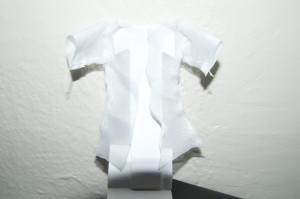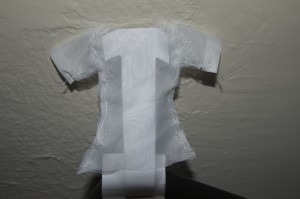The Cloak at Karbala: Inside-out


A contemporary artistic take on Husain’s cloak.
As an artistic reaction to Husain’s martyrdom at Karbala, I created a miniature hand-sewn shirt-cloak inspired by Husain’s story of sacrifice. The base material is white voile fabric. The total size of the piece is 4’’ x 4’’.
Persian Taziyeh dramas honor the act of Husain’s martyrdom. Considerable emphasis is placed on the fact that even when faced with eminent defeat and death, Husain chose to don ragged robes over his garments. In reacting with my handcrafted piece I mirror the connection between the literary and theological in Husain’s clothing choice by focusing on the message of purposeful worldly transcendence.
First off, the cloak plays the role as a transformative symbol. Only after donning it, is Husain able to make his ultimate worldly sacrifice, giving his own life for his followers. Thus, his cloak intrinsically carries a power that is transcendent of exterior worldly appearance. This is reflected in The Miracle Play translated by Colonel Pelly, when Husain makes a request of his sister Zainab to fetch him his ragged dress:
“I am covered with shame before thee. I cannot lift up my head. Though the request is trifle, yet I know it is grievous to thee to grant. It is this; bring me an old, dirty, ragged garment to put on. But do not ask me, I pray thee, the reason why, until I think myself it proper to tell thee.” (Pelly 90)
On the exterior, the dress is unassuming, humble and perhaps even in the eyes of Husain’s enemy, an outwardly undesirable way to die. It’s a curious fashion choice. Other passages in Pelly’s translation label it as “tattered shirt”, “loathsome thing”, “ragged robe” and “mysterious cloak” (Pelly 91). However, despite the outward appearance of his cloak, Husain’s choice of clothing emphasizes the transcendent nature of his sacrifice.
My piece uses the lightweight and semi-transparent qualities of voile fabric to portray Husain’s cloak in an inside-out alternate rendering of his sacrifice. I choose a light cloth (in both color and weight) not just to honor the Taziyeh practice of casting protagonists in white or green, but also to make the theme of fleeting worldliness clear and visually surface the importance of intrinsic purity (Chelkowski 9).
As Husain utters that the “old robe close to my skin, though neither old nor new of this world can be depended on”, he actually preempts his own worldly transcendence as he departs and focuses importance on himself (Pelly 92). His divestment from the worldly signals his followers to invest more faith in the intrinsic than extrinsic; thus Shia recognize their Imam figure as a religious leader who draws authority by nature of direct inward relation to Mohammed through bloodline. The white of the cloak, with the running of white thread on the seams is a nod to the descendants surviving the last prophet’s prophetic light, raising suggested relation to Mohammed’s own cloak The Burda via the embedded color association. Ultimately, by putting the interior of Husain’s martyrdom on the exterior of a cloak, this piece challenges the viewer to think beyond the surface of Husain’s ragged robes and think about the implications of his clothing choice on the meaning of his sacrifice.
-Week 5